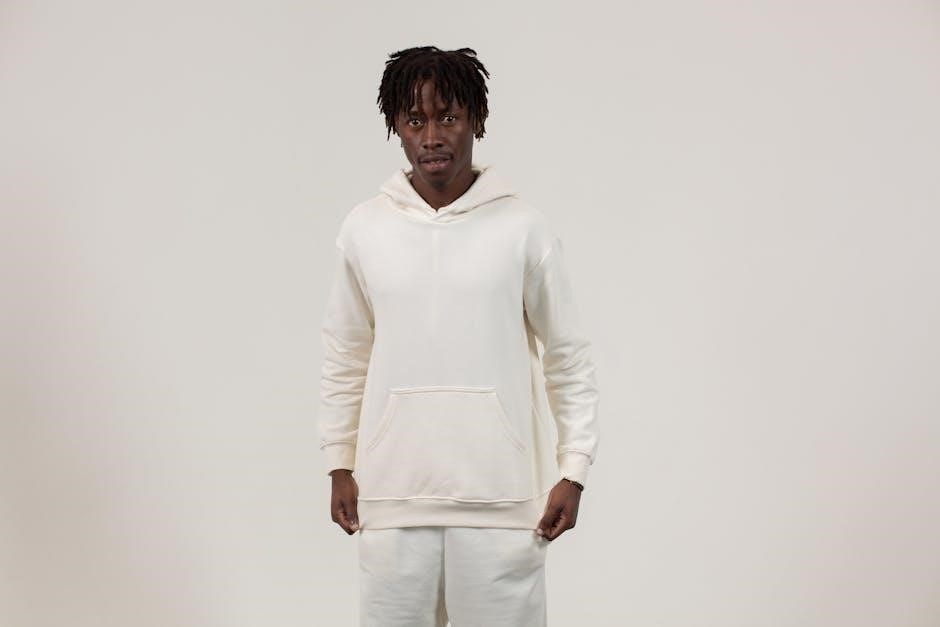A well-fitting pair of pants is essential for both comfort and style. This guide helps you navigate the process of finding the perfect fit‚ ensuring a balance between comfort and aesthetics while catering to different body types and lifestyles.
Understanding the Importance of Proper Fit
A proper fit is crucial for both comfort and style‚ as it ensures pants sit naturally on the body without restriction or excess fabric. Ill-fitting pants can lead to discomfort‚ poor posture‚ and an unflattering appearance. A well-fitted pair enhances confidence‚ allowing for a full range of motion while maintaining a polished look. Whether for formal or casual settings‚ the right fit ensures versatility in styling and complements overall aesthetics. Understanding proper fit is the foundation for making informed choices‚ ensuring pants flatter your physique and align with your lifestyle. This guide will help you master the basics of fit‚ enabling you to select pants that feel great and look even better.
- Proper fit balances comfort and style.
- Ill-fitting pants can cause discomfort and look unflattering.
- A well-fitted pair enhances confidence and versatility.
Key Components of a Well-Fitting Pair of Pants
A well-fitting pair of pants is defined by several key components that ensure both comfort and style. The waist should sit comfortably‚ neither too tight nor too loose‚ providing adequate support without restriction. The inseam and outseam must align with your leg length‚ avoiding excessive fabric at the bottom. The rise‚ which is the distance between the waistband and the crotch‚ should complement your body type and personal preference. Additionally‚ the fit through the hips and thighs is crucial‚ offering enough room for movement while maintaining a streamlined appearance. Finally‚ the fabric choice plays a significant role‚ as it impacts both comfort and durability. These elements combined ensure a pair of pants that feels great and looks sharp.
- Waist: Comfortable and supportive fit.
- Inseam and outseam: Proper length for your legs.
- Rise: Suitable for your body type and style.
- Hip and thigh fit: Balanced comfort and aesthetics.
- Fabric: Durable and comfortable material.
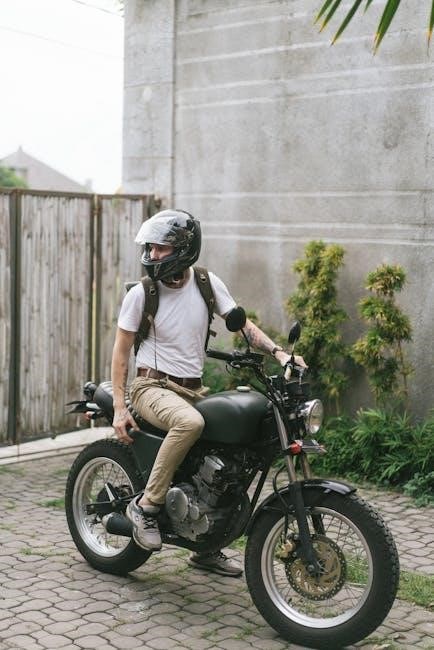
Types of Fits for Men’s Pants
Men’s pants come in various fits‚ each offering unique style and comfort. Slim‚ straight‚ and loose fits cater to different body types and fashion preferences‚ ensuring versatility.
Slim Fit: Characteristics and Styling Tips
The slim fit is a popular choice for men seeking a modern‚ streamlined look. These pants are tailored to sit closely to the body‚ with a narrower cut through the hip‚ thigh‚ and leg. They create a sleek silhouette and are ideal for slimmer builds or those wanting a contemporary style. Pair slim-fit pants with fitted shirts to maintain a cohesive appearance. For a casual look‚ try pairing with a button-down shirt or a graphic tee. Avoid oversized tops to prevent a mismatched look. Styling tips include pairing with leather jackets for an edgy vibe or blazers for a more formal setting. They are versatile‚ suitable for both business casual and social events‚ making them a wardrobe staple for many men. Additionally‚ slim-fit pants can be dressed up or down‚ offering flexibility in styling options. They are particularly flattering when paired with tailored outerwear and clean footwear‚ enhancing the overall polished appearance. This style is perfect for those who prefer a fashionable yet comfortable option.
Straight Fit: A Classic Choice for Comfort and Versatility
The straight fit is a timeless option that offers unparalleled comfort and versatility. Designed to sit naturally on the body‚ these pants feature a straight cut from waist to hem‚ with a moderate fit through the hip and thigh. Unlike slim-fit pants‚ straight-fit styles do not taper or hug tightly‚ providing a relaxed yet polished appearance. They are ideal for men seeking a classic look that works for both casual and semi-formal occasions. Pair straight-fit pants with a button-down shirt for a sharp‚ put-together look or with a sweater for a more relaxed vibe. This fit is also flattering on a variety of body types‚ making it a versatile addition to any wardrobe. Its universal appeal ensures it remains a staple in men’s fashion‚ blending comfort and style effortlessly.
Loose Fit: When and How to Pull Off the Relaxed Look
Loose-fit pants offer a relaxed‚ comfortable silhouette with ample room through the seat‚ thigh‚ and leg. This style is ideal for men who prioritize comfort or have a larger frame‚ as it provides a laid-back‚ casual aesthetic. To pull off the loose fit‚ balance the volume with a fitted top or structured jacket to avoid appearing overly baggy. Opt for neutral or dark colors to create a streamlined look‚ and ensure the pants are not excessively long to maintain proportion. Pair loose-fit pants with sneakers for a casual vibe or dress shoes for a smarter‚ yet relaxed‚ appearance. This versatile fit is perfect for everyday wear‚ offering both comfort and style. Proper tailoring can refine the look while maintaining its relaxed charm.
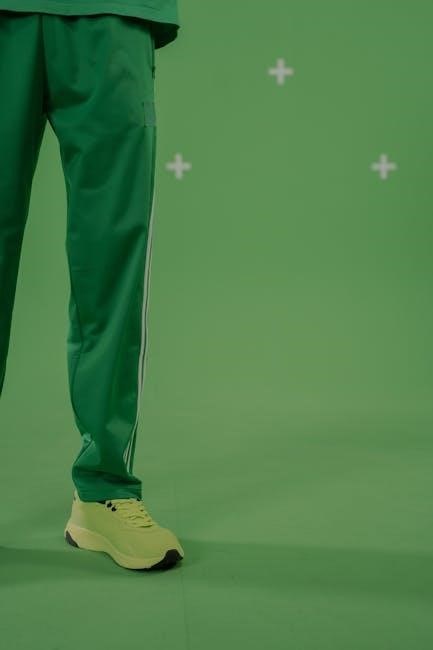
How to Measure Yourself for the Perfect Fit
Measure your waist at the narrowest point‚ inseam from crotch to ankle‚ and hips 7 inches below the waist for accurate sizing and a tailored look.
Waist Measurement: The Foundation of a Good Fit
The waist measurement is crucial for ensuring your pants fit perfectly. To measure accurately‚ stand relaxed and wrap a tape measure around the narrowest part of your natural waistline‚ typically just above the hip bone and below the navel. Ensure the tape is snug but not tight. This measurement determines your pant size‚ so precision is key. For low-rise styles‚ the waistband will sit slightly lower‚ while high-waisted pants will position higher. A correct waist measurement ensures comfort and prevents issues like sagging or constriction. Always refer to sizing charts to match your measurement with the right fit.
Inseam and Outseam: Understanding Pant Length
The inseam and outseam are essential measurements for determining pant length. The inseam measures from the crotch seam to the bottom of the pant leg‚ indicating how long the pants are. The outseam‚ including the waistband‚ runs from the top of the waist to the pant’s bottom. These measurements ensure proper fit and style. For example‚ slim-fit pants typically have a shorter inseam and outseam for a streamlined look‚ while loose-fit pants offer more length for a relaxed appearance. Accurate inseam and outseam measurements are vital to avoid pants that are too short or overly long‚ ensuring a balanced and flattering silhouette.
Hip and Thigh Measurements: Ensuring Comfort and Style
Hip and thigh measurements are crucial for a comfortable and stylish fit. The hip measurement‚ taken around the widest part of the hips‚ ensures the pants sit comfortably without restriction. Thigh measurements determine the roominess through the leg‚ preventing tightness and discomfort. Pants with a slimmer thigh fit are ideal for lean builds‚ while loose-fit styles accommodate larger or more muscular thighs. Proper hip and thigh measurements ensure the pants move smoothly with the body‚ balancing comfort and style. This attention to detail helps avoid common issues like restricted movement or an unflattering silhouette‚ making it essential for achieving the perfect fit in any pant style.

Common Fitting Mistakes to Avoid
Avoid pants that are too tight‚ restricting movement‚ or too loose‚ causing an unflattering sag. Ensure the rise is appropriate for your body type to maintain comfort and style.
Pants That Are Too Tight: The Risks of Over-Tightening
While a slim fit can be stylish‚ pants that are too tight can be uncomfortable and unflattering. Over-tightening restricts movement and may lead to discomfort throughout the day. Additionally‚ tight pants can create an unappealing silhouette‚ accentuating areas you might prefer to keep subtle. They can also cause health issues‚ such as restricted blood flow or skin irritation. To avoid this‚ ensure there’s enough room in the thigh and hip areas without sacrificing style. A balanced fit is key—opt for pants that skim your body without feeling constricting. Proper tailoring or adjustments can make all the difference‚ ensuring both comfort and a polished look. Always prioritize how the pants feel while moving‚ as this is a clear indicator of a good fit.
Pants That Are Too Loose: Avoiding the Saggy Look
Pants that are too loose can create an unflattering‚ saggy appearance that lacks style and structure. While comfort is important‚ excessively loose pants can make you look larger than you are and detract from your overall aesthetic. To avoid this‚ ensure your pants fit well around the waist and maintain a balanced silhouette. Avoid fabrics that stretch excessively or styles designed for larger body types if they don’t suit your frame. Tailoring can help adjust loose areas while preserving comfort. Opt for a fit that skims your body without being restrictive‚ ensuring a polished and put-together look. Proper fit is key to avoiding the saggy‚ ill-fitting appearance that can undermine your personal style.
Incorrect Rise: Finding the Right Balance
The rise of your pants‚ which refers to the distance between the waistband and the crotch seam‚ plays a crucial role in both comfort and style. A rise that is too low can cause the pants to sit uncomfortably below your natural waistline‚ potentially leading to a saggy appearance. Conversely‚ a rise that is too high can feel restrictive and unflattering‚ especially if it doesn’t align with your body type. The ideal rise should strike a balance‚ sitting comfortably around your natural waist to provide support without feeling constricting. Pay attention to mid-rise‚ low-rise‚ and high-rise options to determine which best complements your physique and personal style for a polished‚ confident look.
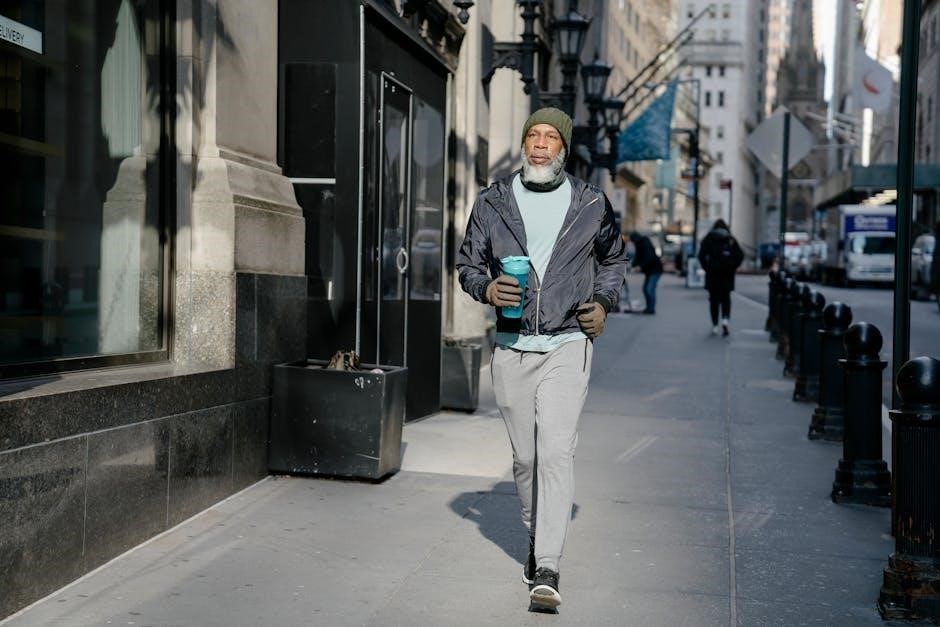
Fabric and Style Considerations
Fabric and style choices significantly impact the comfort and aesthetic of your pants. Opt for breathable fabrics like cotton or linen for casual wear‚ while wool or cashmere suits formal occasions. Consider stretch fabrics for enhanced mobility. Style-wise‚ slim fits offer a modern look‚ while loose fits provide laid-back comfort. Ensure your choices align with your lifestyle and personal taste to create a versatile wardrobe. Tailoring can refine the fit‚ ensuring a polished appearance regardless of fabric or style selection.
Choosing the Right Fabric for Your Lifestyle
Selecting the right fabric is crucial for comfort and functionality. For casual‚ everyday wear‚ cotton and linen are excellent choices due to their breathability and softness. If you prioritize durability‚ denim is a timeless option‚ suitable for jeans and workwear. For formal occasions‚ wool or cashmere offers a luxurious feel and sharp appearance. Consider stretch fabrics like elastane blends for active lifestyles‚ as they provide flexibility and ease of movement. Moisture-wicking fabrics are ideal for athletic or outdoor activities‚ keeping you dry and comfortable. Additionally‚ seasonal fabrics like lightweight linen for summer and thick wool for winter ensure your wardrobe adapts to changing weather conditions. Always match fabric choice to your lifestyle and needs for optimal comfort and style.
Understanding Different Pant Styles: Chinos‚ Jeans‚ Dress Pants
Chinos‚ jeans‚ and dress pants each serve distinct purposes in a man’s wardrobe. Chinos are versatile‚ made from cotton or twill fabric‚ and offer a smart-casual look suitable for both everyday wear and semi-formal events. Jeans‚ crafted from durable denim‚ are timeless and perfect for casual outings‚ available in various washes and styles. Dress pants‚ typically made from wool or cashmere‚ are designed for formal occasions‚ offering a polished appearance when paired with a blazer or button-down shirt. Each style caters to different needs‚ ensuring men can dress appropriately for any setting while maintaining comfort and style.
The Role of Tailoring in Achieving the Perfect Fit
Tailoring ensures a flawless fit by adjusting pants to your unique measurements‚ offering expert alterations for comfort and style‚ and using high-quality materials for lasting durability.
When to Consult a Professional Tailor
Consulting a professional tailor is essential for achieving a precise fit‚ especially when off-the-rack pants don’t meet your needs. They can adjust waistbands‚ hem lengths‚ and leg openings to ensure a flattering silhouette. Tailors are particularly useful for altering high-end or bespoke garments‚ where fit is crucial. Additionally‚ if you struggle with finding pants that fit your unique body type‚ a tailor can create custom pieces tailored to your measurements. Their expertise ensures that your pants not only fit perfectly but also enhance your overall style‚ making them a worthwhile investment for any man seeking impeccable tailoring.
DIY Alterations: What You Can Do at Home
While professional tailoring offers precision‚ some alterations can be done at home to refine your pants’ fit. Simple adjustments like hemming pants to the perfect length or taking in the waistband can enhance comfort and style. For those with basic sewing skills‚ tightening the seat or thighs can create a slimmer silhouette. Shortening the inseam or adjusting the rise are also achievable with minimal tools. However‚ more complex changes‚ like re-shaping the leg opening‚ may require professional expertise. DIY alterations are a cost-effective way to personalize your pants‚ but they may lack the polish of tailored modifications. Still‚ they can make a significant difference in achieving a more tailored look.
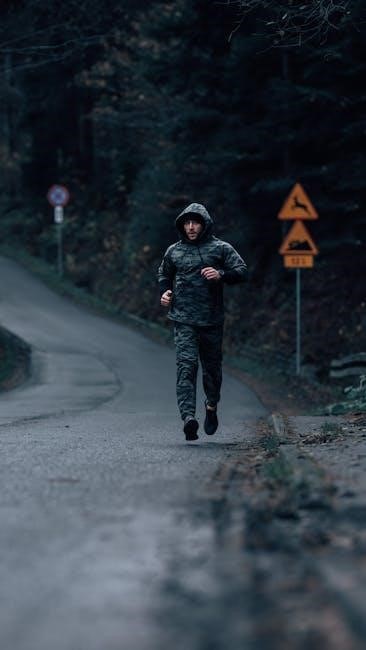
Trends in Men’s Pants Fit
Current trends emphasize comfort and versatility‚ with a focus on athleisure influences and innovative fabrics. Slim and loose fits continue to evolve‚ balancing style with practicality for modern lifestyles.
The Rise of Athleisure and Its Impact on Pant Fit
Athleisure has revolutionized men’s fashion‚ blending athletic comfort with stylish designs; This trend emphasizes pants with stretch fabrics‚ drawstring waistbands‚ and tapered or relaxed fits. The focus is on versatility‚ allowing pants to transition seamlessly from casual outings to semi-formal events. Its influence has led to the creation of hybrid styles‚ such as chino joggers and dress sweatpants‚ which offer both comfort and a polished look. As a result‚ modern pant designs prioritize flexibility and practicality without compromising on aesthetics‚ making athleisure a cornerstone of contemporary men’s wardrobes. This shift has redefined how men approach pant fit‚ valuing ease of movement and everyday comfort.
Current Fashion Trends: Slim vs. Loose Fits
Current fashion trends in men’s pants continue to swing between slim and loose fits‚ catering to diverse styles and body types. Slim-fit pants remain popular for their streamlined silhouette‚ offering a modern‚ tailored look that works well for both casual and formal settings. Loose-fit pants‚ on the other hand‚ embrace comfort and relaxation‚ with a focus on ease of movement and a laid-back aesthetic. The trend leans toward versatility‚ with many designs blending elements of both styles to create a balanced look. Whether you prefer the sharp lines of slim fits or the relaxed vibe of loose fits‚ the key is to choose a style that aligns with your lifestyle and personal taste. Both options are wardrobe staples‚ ensuring there’s something for everyone in today’s fashion landscape.

Styling Tips for Different Body Types
Styling pants for different body types requires tailoring your choice to your physique. Slim builds can add volume with loose fits‚ while athletic frames benefit from tapered styles. Larger frames look sharp in streamlined‚ tailored options. Balance proportions and prioritize comfort for a confident look.
Slender Builds: How to Add Volume with Fit
For slender builds‚ choosing the right fit can create the illusion of more volume. Opt for straight or loose-fit pants‚ as they add structure without overwhelming your frame. Higher-rise styles can also elongate your torso‚ creating a balanced silhouette. Tapered legs or subtle details like pocket stitching can draw the eye outward‚ adding visual width. Avoid overly slim fits that cling too tightly‚ as they may emphasize leanness. Instead‚ select fabrics with texture or weight to add depth. Pairing with tailored tops or jackets can further enhance proportions. Ensure inseam isn’t too short to avoid a disconnected look. Confidence and proper fit are key to styling for slender builds effectively.
Finding the perfect fit is a balance of comfort‚ style‚ and confidence. Tailoring‚ measurements‚ and understanding your body type are key to unlocking a flattering‚ well-fitting wardrobe.
Summing Up the Key Takeaways
Properly fitting pants are crucial for comfort and style. Measure your waist‚ inseam‚ and hip to ensure accuracy. Consider your lifestyle and body type when choosing between slim‚ straight‚ or loose fits. Avoid pants that are too tight or too loose‚ as they can be unflattering. Pay attention to rise—mid-rise is a versatile option. Fabric choice matters for durability and comfort. Tailoring can make a significant difference in achieving the perfect fit. Experiment with styles to find what works best for you‚ and remember‚ confidence completes any outfit.
Encouragement to Experiment and Find Your Style
Experimenting with different fits and styles is key to discovering what works best for you. Don’t be afraid to try new silhouettes‚ fabrics‚ or rises to elevate your wardrobe. Whether you prefer slim‚ straight‚ or loose fits‚ the goal is to feel confident and authentic. Remember‚ fashion is a form of self-expression‚ and pants are a foundational piece that can transform your look. By understanding your body type and lifestyle‚ you can curate a collection that flatters and empowers. Embrace the journey of finding your personal style—it’s a process that leads to a wardrobe that truly reflects who you are. Confidence‚ after all‚ is the ultimate accessory.
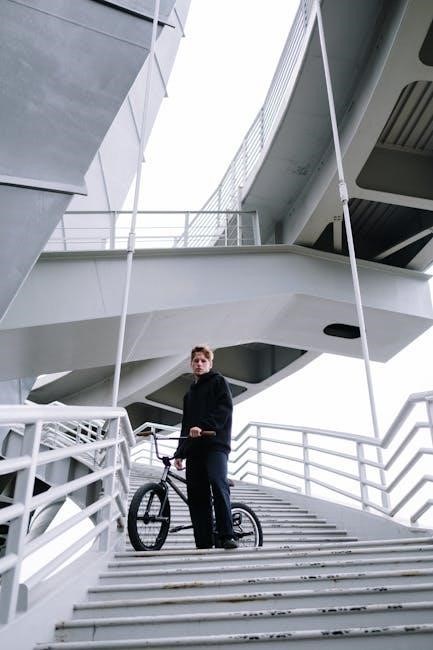
Resources for Further Reading
Explore our recommended guides and articles for deeper insights into men’s pants fit‚ styles‚ and sizing. Visit The Ultimate Guide to Men’s Pants Fit and How Pants Should Fit: A Complete Guide for expert tips. Check out Bespoke Unit and GAZMAN for detailed fit breakdowns and styling advice. These resources will help you refine your understanding and make informed choices.
- Proper Cloth Dress Pants Guide
- The Styleforum Journal
Recommended Articles and Guides
For a deeper understanding of men’s pants fit‚ explore these expert resources. The Ultimate Guide to Men’s Pants Fit offers comprehensive insights‚ while How Pants Should Fit: A Complete Guide provides practical tips; Visit Bespoke Unit for detailed fit breakdowns and styling advice. Additionally‚ Proper Cloth and The Styleforum Journal share expert recommendations on trouser styles and measurements. These guides will help refine your understanding of fit‚ styles‚ and sizing‚ ensuring you make informed choices.
- Proper Cloth Dress Pants Guide
- The Styleforum Journal
These resources are essential for mastering the art of finding perfectly fitting pants‚ whether for casual or formal occasions.
Where to Shop for Well-Fitting Pants
Discover the best destinations for purchasing pants that flatter your physique. Proper Cloth and Bonobos are known for their tailored fits and customizable options. For premium denim‚ consider Levi’s or Gap‚ which offer a variety of styles. J.Crew provides classic fits with a modern twist‚ while DUER specializes in performance-driven designs. Online platforms like Connell Brothers and GAZMAN offer curated collections for every taste. Explore these retailers to find pants that align with your lifestyle and style preferences. You can visit Proper Cloth or Bonobos to shop their collections.
These brands ensure a perfect blend of comfort‚ style‚ and quality‚ helping you build a wardrobe of well-fitting pants.
